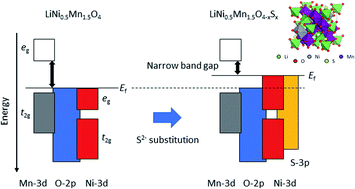Metastable oxysulfide surface formation on LiNi0.5Mn1.5O4 single crystal particles by carbothermal reaction with sulfur-doped heterocarbon nanoparticles: new insight into their structural and electrochemical characteristics, and their potential applications†
Abstract
Spinel LiNi0.5Mn1.5O4 (LNMO) and related compounds have attracted much attention as high voltage cathode material for lithium ion batteries. However, their strong Lewis basic characteristics shown at the surface promotes various side reactions in associating with the oxidative decomposition of the electrolyte, leading to significant capacity degradation with increasing cycle numbers. We proposed multi-anion surfaces (such as oxyfluoride) for the direct tuning of the electronic properties for the cathode surface. In this study, we report the synthesis of LNMO single crystals with an oxysulfide surface and characterization of their electrochemical properties. A carbothermal reaction at around 450 °C with sulfur-doped hydrocarbon (S-HC) nanoparticles as a solid-phase precursor made it possible to prepare the metastable oxysulfide surface without the excess-reduction of transition metals in the spinel frame. This systematic study, using experimental and theoretical approaches, revealed many new findings for understanding the oxysulfide surface effects. The incorporated S2− were preferentially occupied at O24e-sites (P4332), which are bonded with three transition metals containing single Ni2+ and double Mn4+, leading to mitigating the cation mixing of Li+/Ni2+ formed at the surface and reducing the surface energy of {100} faces, resulting in significant changes in the corresponding electric structures, large morphological changes and an increase of specific capacity, as well as significant cyclability enhancement. Furthermore, it was found that the S-3p orbital appeared newly at a higher level than the Ni-3d orbital, resulting in dramatic changes of their electrical properties, including the narrowing of band gap and lowering the overpotential for the redox reaction of Ni2+/Ni3+.



 Please wait while we load your content...
Please wait while we load your content...
